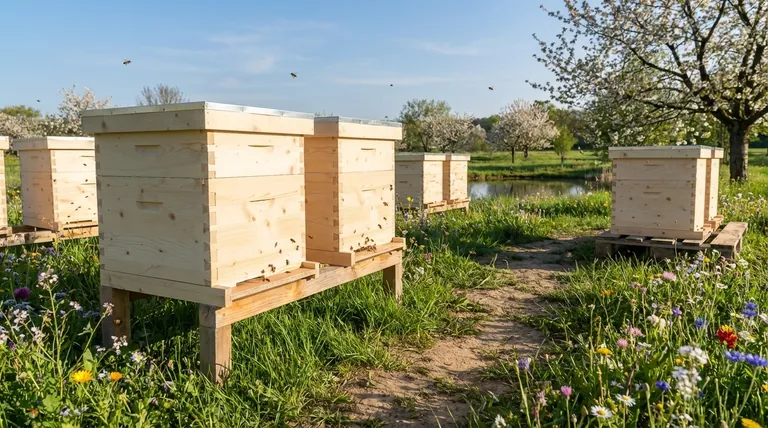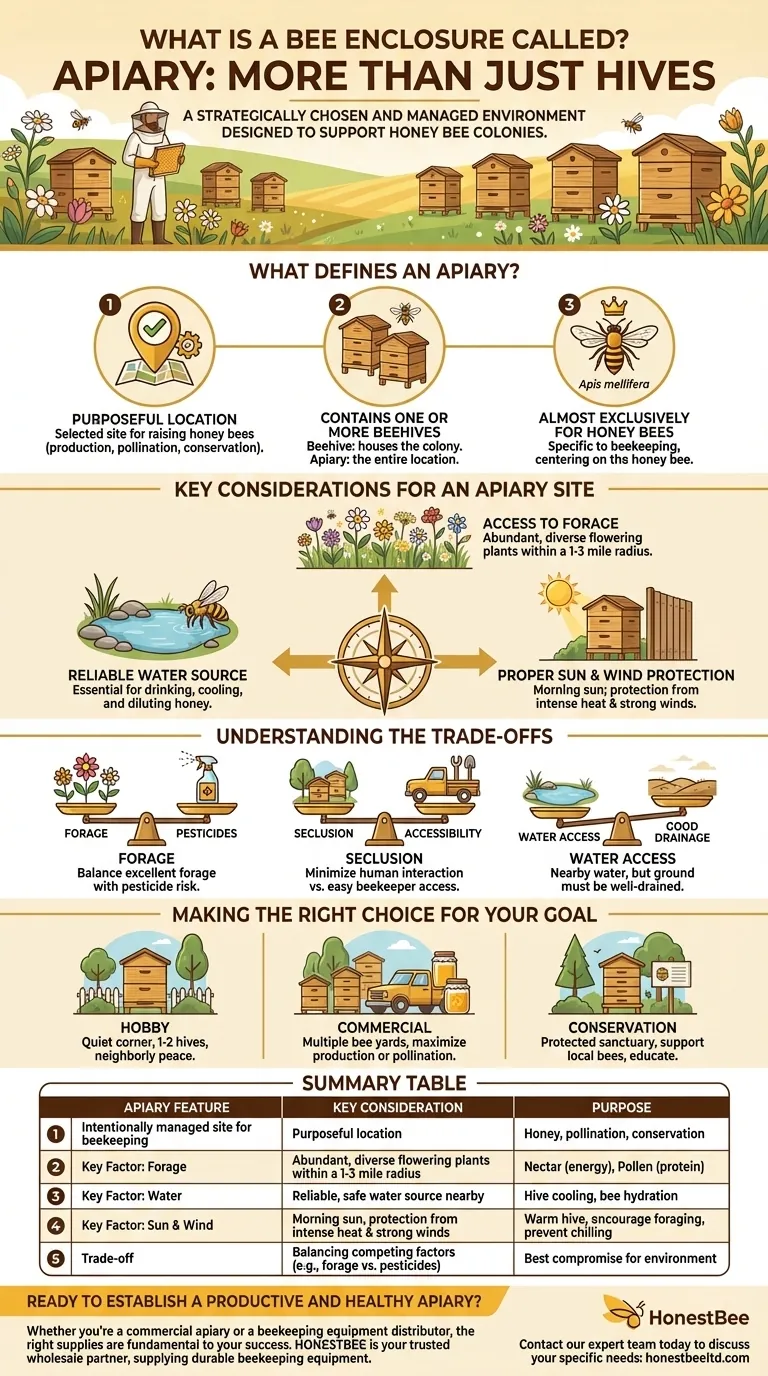A location where beehives are kept is called an apiary. This term, also known as a bee yard, refers to the entire designated area where a beekeeper manages one or more honey bee colonies. It encompasses not just the hives themselves, but the specific site they occupy.
An apiary is more than just a collection of hives; it's a strategically chosen and managed environment designed to support the health, safety, and productivity of honey bee colonies.

What Defines an Apiary?
While the term can apply to a single hive in a garden, it more accurately describes a location that has been intentionally set up for the purpose of beekeeping.
It's a Purposeful Location
An apiary is not an accidental gathering of bees. It is a site selected by a beekeeper for raising honey bees, whether for honey production, pollination services, or conservation.
It Contains One or More Beehives
A single beehive in a backyard technically creates an apiary. Commercial operations may have hundreds of hives spread across multiple apiaries, or bee yards. The beehive is the physical structure that houses a single bee colony, while the apiary is the entire location where these hives are placed.
It's Almost Exclusively for Honey Bees
The term "apiary" is specific to the management of honey bees (Apis mellifera). While other bee species are vital pollinators, this term refers to the practice of beekeeping, which centers on the honey bee.
Key Considerations for an Apiary Site
The success of the bee colonies is directly tied to the quality of the apiary's location. A good beekeeper thinks like a real estate agent, focusing on "location, location, location."
Access to Forage
Bees need access to a variety of flowering plants that provide nectar (for energy) and pollen (for protein). A good apiary is located within a 1-3 mile radius of abundant and diverse forage.
A Reliable Water Source
Bees require water for drinking, cooling the hive in hot weather, and diluting honey to feed to larvae. A nearby water source, such as a pond, stream, or even a birdbath with pebbles for safe landing, is essential.
Proper Sun and Wind Protection
The ideal location receives morning sun to warm the hive and encourage foraging, but offers protection from intense afternoon heat. It should also be sheltered from strong prevailing winds, which can chill the hive and make it difficult for bees to fly.
Understanding the Trade-offs
Choosing a site for an apiary involves balancing several competing factors. There is no single "perfect" spot, only the best compromise for a given environment.
Forage vs. Pesticides
Placing an apiary near agricultural fields can provide excellent forage, but it also carries the significant risk of pesticide exposure. Beekeepers must be aware of local spraying schedules and practices.
Seclusion vs. Accessibility
Hives should be placed away from high-traffic areas, playgrounds, and property lines to minimize unwanted human-bee interactions. However, the apiary must still be easily accessible for the beekeeper to inspect hives and transport heavy equipment and honey supers.
Water Access vs. Good Drainage
While a nearby water source is critical, the ground directly under the hives must be well-drained. Hives placed in damp, low-lying areas are prone to moisture problems, which can lead to disease and colony loss.
Making the Right Choice for Your Goal
Understanding the term helps clarify the scale and intent behind a beekeeping endeavor.
- If your primary focus is hobby beekeeping: Your apiary might be a quiet corner of your backyard with one or two hives, carefully managed to ensure neighborly peace.
- If your primary focus is commercial production: Your operation will consist of multiple apiaries (bee yards), each strategically placed to maximize honey production or fulfill pollination contracts.
- If your primary focus is conservation: An apiary could be a protected sanctuary designed to support local bee populations and educate the public.
Ultimately, an apiary represents a deliberate partnership between a beekeeper and the remarkable honey bee colonies they manage.
Summary Table:
| Apiary Feature | Key Consideration |
|---|---|
| Purpose | Intentionally managed site for beekeeping (honey, pollination, conservation) |
| Key Factor: Forage | Abundant, diverse flowering plants within a 1-3 mile radius |
| Key Factor: Water | Reliable, safe water source nearby for hive cooling and bee hydration |
| Key Factor: Sun & Wind | Morning sun, protection from intense afternoon heat and strong winds |
| Trade-off | Balancing forage access with pesticide risk; seclusion with beekeeper accessibility |
Ready to establish a productive and healthy apiary?
Whether you're a commercial apiary or a beekeeping equipment distributor, the right supplies are fundamental to your success. HONESTBEE is your trusted wholesale partner, supplying durable beekeeping equipment designed to support thriving colonies and maximize your operational efficiency.
Contact our expert team today to discuss your specific needs and discover how our wholesale solutions can benefit your business.
Visual Guide

Related Products
- Wholesales Dadant Size Wooden Bee Hives for Beekeeping
- Yellow Plastic Bucket Pail Perch for Beekeeping
- White Cotton Beekeeping Jacket and Veil for Bee Keepers
- Heavy-Duty Stainless Steel Clip-On Frame Perch
- JZBZ Langstroth Queen Rearing Frame for Beekeeping
People Also Ask
- What types of products are available for beekeeping needs? Essential Equipment for Apiaries & Distributors
- What should beginners consider when purchasing beekeeping equipment? A Guide to Essential Starter Gear
- What are the characteristics of oil-based paint for beehives? Durability vs. Modern Practicality
- How often should the area under beehives be inspected and cleaned during the warm season? A Proactive Maintenance Guide
- What should you do if you find an ant nest near your beehive? Essential Strategies for Hive Protection



















